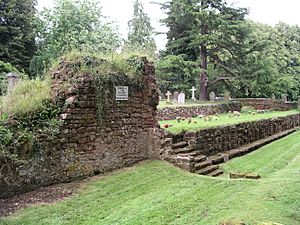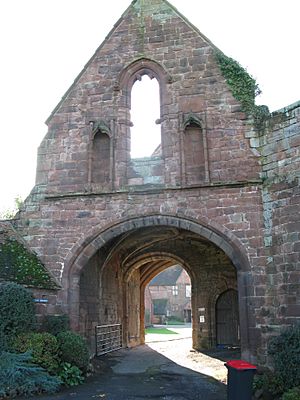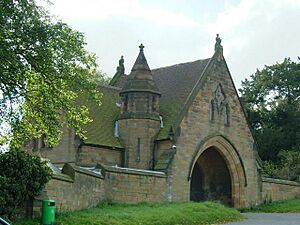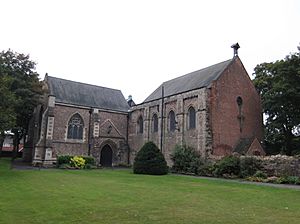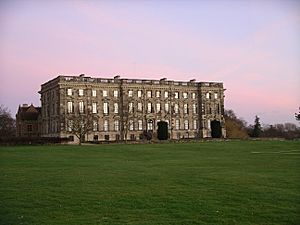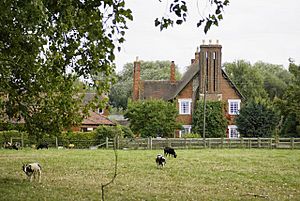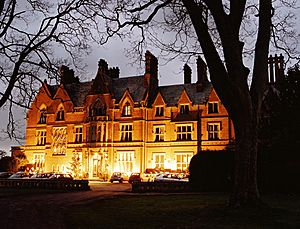List of monastic houses in Warwickshire facts for kids
Monastic houses were special places where groups of people, like monks or nuns, lived together under religious rules. They dedicated their lives to prayer, study, and work. These places were very important in England a long time ago, especially during the Middle Ages. They often served as centers for learning, farming, and helping the local community.
In Warwickshire, a county in England, there were many such monastic houses. Each had its own history, from when it was founded to what happened to it, especially during the time known as the Dissolution of the Monasteries in the 1500s. This was when King Henry VIII closed down many of these religious houses across England.
Contents
- What Were Monastic Houses?
- Important Monastic Houses in Warwickshire
- Alcester Abbey
- Alvecote Priory
- Arbury Priory
- Atherstone Austin Friars
- Bretford Priory
- Cawston Grange
- Coombe Abbey
- Kenilworth Abbey
- Maxstoke Priory
- Merevale Abbey
- Monks Kirby Priory
- Nuneaton Priory
- Oldbury Priory
- Pinley Priory
- Polesworth Abbey
- Stoneleigh Abbey
- Studley Priory
- Thelsford Priory
- Warmington Priory
- Warwick Monastic Houses
- Wolston Priory
- Wootton Wawen Priory
- Wroxall Priory
- See also
What Were Monastic Houses?
Monastic houses were religious communities where people lived apart from the rest of society. They followed strict rules, often focusing on prayer, work, and helping others. These communities were led by an Abbot (for monks) or an Abbess (for nuns).
There were different types of monastic groups, each with their own traditions:
- Benedictine monks and nuns: These followed the rules of St. Benedict. They focused on a balanced life of prayer, work, and study.
- Augustinian Canons Regular: These were priests who lived in a community under the rules of St. Augustine. They often served local churches.
- Cistercian monks and nuns: Known for their simple lives and hard work, often in remote areas. They were famous for farming and building.
- Friars: Unlike monks who stayed in one monastery, friars traveled and preached. Examples include the Augustinian Friars and Dominican Friars (also called Blackfriars).
- Knights Templar and Knights Hospitaller: These were military-religious orders. They protected pilgrims and cared for the sick, especially during the Crusades.
Important Monastic Houses in Warwickshire
Here are some of the notable monastic houses that once existed in Warwickshire:
Alcester Abbey
Alcester Abbey was a home for Benedictine monks. It started around 1138. Later, it became a smaller part of Evesham Abbey. In 1536, like many others, it was closed down. Its stones were even used to build a nearby manor house.
Alvecote Priory
Alvecote Priory was another place for Benedictine monks. It was founded in 1159 and was connected to Great Malvern. It was also closed in 1536.
Arbury Priory
Arbury Priory began after 1154 and housed Augustinian Canons Regular. These were priests living together. The priory became independent in 1235. After it closed in 1534, a grand house called 'Arbury Hall' was built on its site, which you can still see today.
Atherstone Austin Friars
Atherstone Austin Friars was home to Augustinian Friars, who were traveling preachers. It was founded in 1374. When it closed in 1538, part of its church was kept and used as a local parish church.
Bretford Priory
Bretford Priory was a small community for Benedictine nuns, started before 1154. It was later taken over by Kenilworth Abbey and closed before 1167.
Cawston Grange
This was a Cistercian monks farm, connected to Pipewell Abbey. It was founded after 1201 and was used for farming. It was destroyed by fire once but rebuilt. Today, a farmhouse stands where it used to be.
Coombe Abbey
Coombe Abbey was a large monastery for Cistercian monks, founded in 1150. After it closed in 1539, a big house was built there. Today, it's a hotel and its grounds are a popular country park.
Kenilworth Abbey
Kenilworth Abbey was a significant place for Augustinian Canons Regular. It started as a priory around 1125 and became an abbey after 1439. It closed in 1539, and some of its stones were used to build Kenilworth Castle.
Maxstoke Priory
Maxstoke Priory was founded in 1336 for Augustinian Canons Regular. It was dedicated to the Holy Trinity and other saints. It closed in 1536, and some of its old buildings are now part of a farm.
Merevale Abbey
Merevale Abbey was a home for Cistercian monks, founded in 1148. It closed in 1538. Interestingly, its old gatehouse chapel is still used as a church today.
Monks Kirby Priory
Monks Kirby Priory housed Benedictine monks and was connected to a monastery in France. It was founded in 1077. It closed and reopened a few times before finally being granted to Trinity College, Cambridge in 1545. Parts of it are now in St Edith's Church.
Nuneaton Priory
Nuneaton Priory was a unique "double house" for both Benedictine nuns and monks, founded around 1155. It closed in 1539, and a church, St Mary's, was built on its site in 1876.
Oldbury Priory
This priory was for Benedictine nuns, possibly founded as early as 1066. The nuns later moved to Polesworth. It continued as a small chapel for some time.
Pinley Priory
Pinley Priory was a home for Cistercian nuns, founded before 1135. It was closed in 1536.
Polesworth Abbey
Polesworth Abbey was a very old monastery for Benedictine nuns, possibly founded before 839! It had a long history of being moved and refounded. It finally closed in 1539, but its church is still used as the Parish Church of St Editha.
Stoneleigh Abbey
Stoneleigh Abbey was for Cistercian monks. The community moved here in 1154. It closed in 1536, and a country house called 'Stoneleigh Abbey House' was built on its site, which has been changed over the centuries.
Studley Priory
Studley Priory was for Augustinian Canons Regular. The community moved here around 1151. The church was rebuilt in 1309. It closed in 1536, and now a farmhouse stands on the site.
Thelsford Priory
Thelsford Priory was for Augustinian Canons Regular of the Holy Sepulchre, and later for Trinitarians, an order focused on ransoming captives. It was refounded around 1214 and closed in 1538.
Warmington Priory
Warmington Priory was a small house for Benedictine monks, connected to a monastery in France. It was founded before 1123. It closed around 1387.
Warwick Monastic Houses
The town of Warwick had several monastic sites:
- Warwick Blackfriars: This was for Dominican Friars, founded before 1263. It closed in 1538.
- Warwick St Sepulchre Priory: This was for Augustinian Canons Regular, founded around 1119. It closed in 1536, and parts of its buildings were even moved to Virginia in the USA!
- Warwick Preceptory: This was for the Knights Templar, a military-religious order, founded around 1135. After the Templars were dissolved, it passed to the Knights Hospitaller.
Wolston Priory
Wolston Priory was for Benedictine monks and was connected to a French monastery. It was founded between 1086 and 1094 and closed in 1394.
Wootton Wawen Priory
Wootton Wawen Priory was another place for Benedictine monks, also connected to a French monastery. It was founded after 1086 and closed in 1447.
Wroxall Priory
Wroxall Priory was for Benedictine nuns, founded around 1135. It closed in 1536. Today, a large house called 'Wroxall Abbey' stands on the site and is used as a hotel.
See also



